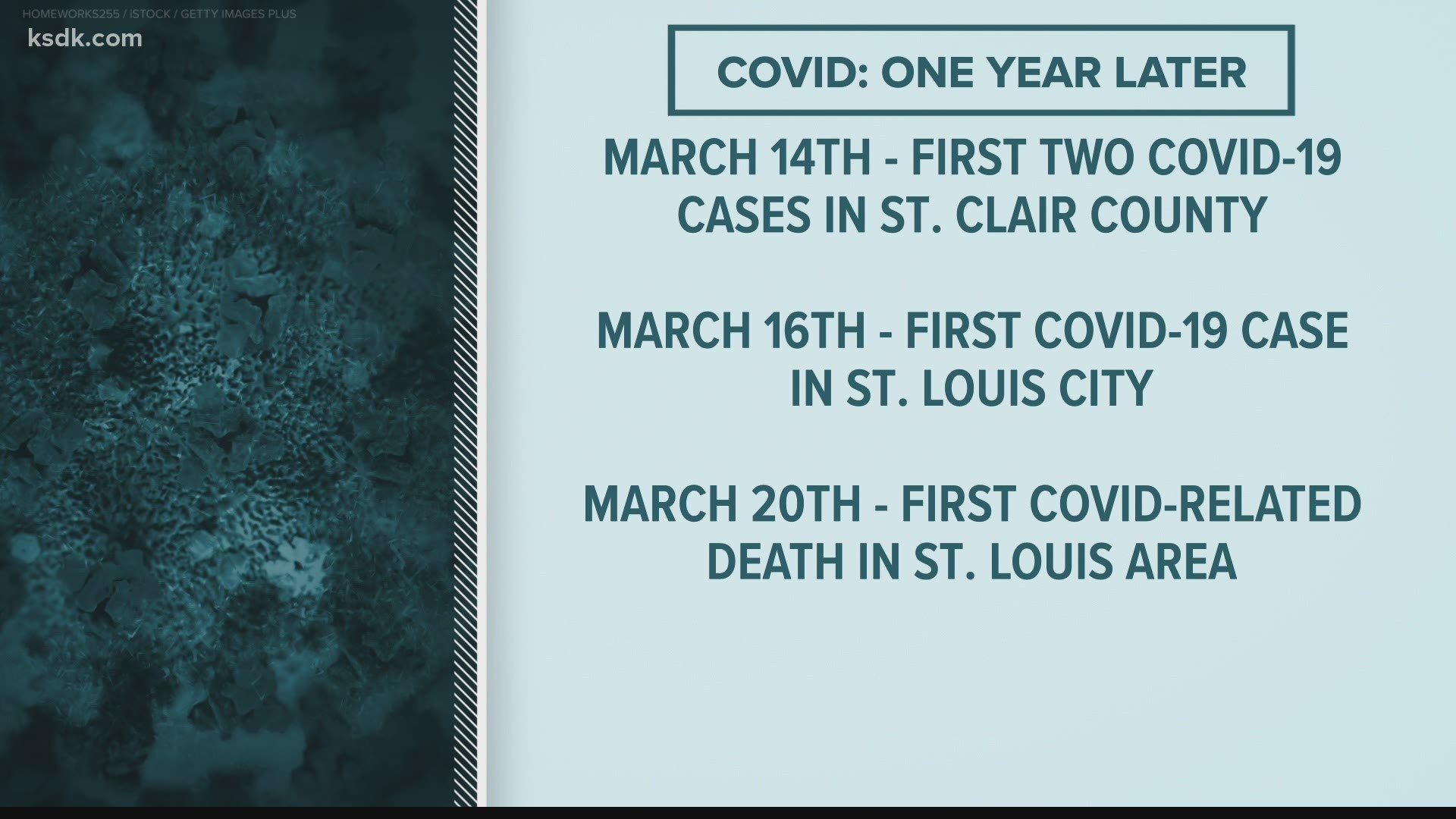ST. LOUIS — It has been one year since the first confirmed case of COVID-19 was reported in the St. Louis area. Since March 7, 2020, thousands have been infected with the coronavirus and thousands have lost their lives.
The Missouri Department of Health and Senior Services reports, as of March 5, 2021, there have been a total of 479,966 cases and 8,156 deaths related to the virus. The Illinois Department of Public Health reports 1,194,702 cases of the virus and 20,700 deaths.
The pandemic has touched nearly every aspect of our lives and caused a crisis on many fronts: the economy, public safety, mental health and education.
Missouri's 1st COVID-19 case
The first confirmed case of COVID-19 was a young woman who had traveled to Italy — one of the countries hardest-hit during the early stages of the pandemic. She returned to the U.S., first landing at Chicago's O'Hare airport and then taking an Amtrak train from Chicago to St. Louis. She arrived in the St. Louis area on March 4.
The next day, the woman called St. Louis County's health line and complained of symptoms. County Executive Sam Page said health officials told the woman and her family to self-quarantine — a point that was later refuted by the family's attorney.
A private St. Louis County school, Villa Duchesne, confirmed that the younger sister of the young woman who eventually tested positive attended classes on March 5 and March 6. During that weekend, the sister and the young woman's father attended a father-daughter dance at the Ritz-Carlton Hotel in Clayton. They left after they found out the young woman's test was positive.
Missouri Gov. Mike Parson announced the positive test result during a press conference on March 7.
MARCH 2020: A timeline of coronavirus in Missouri
Missouri's first COVID-19-related death
The first death of a person in the St. Louis area was reported on March 20. Judy Wilson-Griffin worked at SSM Health St. Mary’s Hospital.
“Judy Wilson-Griffin was a beloved member of our SSM Health St. Mary’s Hospital family. Our hearts break for her family and friends and we will keep them in our prayers as we cope with the loss of our cherished colleague and friend," a hospital spokesperson said in a statement.
By the end of March, about 20 people were quarantined and "under surveillance" in the City of St. Louis and St. Louis County, health officials said. At that point, there were about 80,000 confirmed cases of the virus around the world.
As the virus spread throughout the community, testing and personal protective equipment were difficult to come by. People made their own masks from supplies they had at home.
St. Louisans started to hear phrases like "bend the curve", "flatten the curve" and "social distancing" and they were urged to stay home as much as possible.
And a virus that was thought to impact primarily elderly people started to infect seemingly healthy middle-aged adults. They shared stories of their battle with the virus and eventual recovery.
MARCH 2020: Young mother battling COVID-19: 'I would have not left my house if I knew how miserable this was'
Closures, cancellations, stay-at-home orders
In the spring, St. Louisans became accustomed to seeing big events getting canceled, like the St. Patrick's Day Parade and Cardinals Opening Day. The area's most popular attractions, like the Saint Louis Zoo, also shuttered.
Public officials announced stay-at-home orders, forcing non-essential businesses to close. Illinois' stay-at-home order took effect on March 21. On April 6, Missouri went statewide under a stay-at-home order, which lasted until May 3. Some local municipalities, including St. Louis and St. Louis County, chose to extend their stay-at-home orders.
By the beginning of summer, some businesses started to reopen. But the progress that was made to reduce the spread during the early summer months was short-lived. By late summer, COVID-19 cases surged in the St. Louis area, prompting many public school districts to start their school year with online instruction.
Public health officials pleaded with people to continue to stay home and wear masks, as health care workers worked to care for sick patients and hospitals were nearly full. Mask-wearing became a political issue. Despite pleas from the St. Louis Metropolitan Pandemic Task Force, Parson maintained he would never call for a statewide mandate, leaving the decision to local officials.
A shot in the arm
As the holiday season approached, health officials urged people to avoid traveling and gathering with people who did not live in their households. Many people hoped it would be the last time they would experience a socially distant holiday with their loved ones. The FDA had approved Pfizer's COVID-19 vaccine for emergency use.
In December, Missouri and Illinois started receiving their first shipments of vaccines. And on Dec. 14, 2020, the first person in the St. Louis area received the vaccine.
However, distribution and rollout continue to frustrate individuals seeking the vaccine and the various entities administering them.

